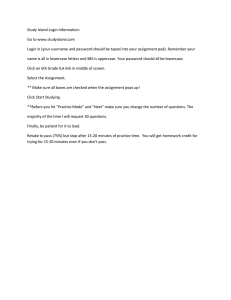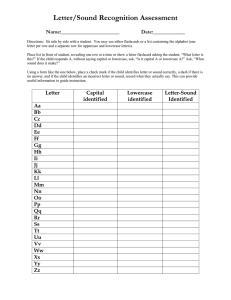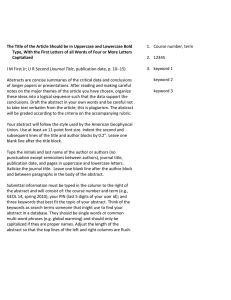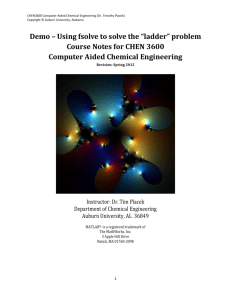– Computer-Aided Chemical Engineering CHEN3600 Spring 2012 Chemical Engineering Department
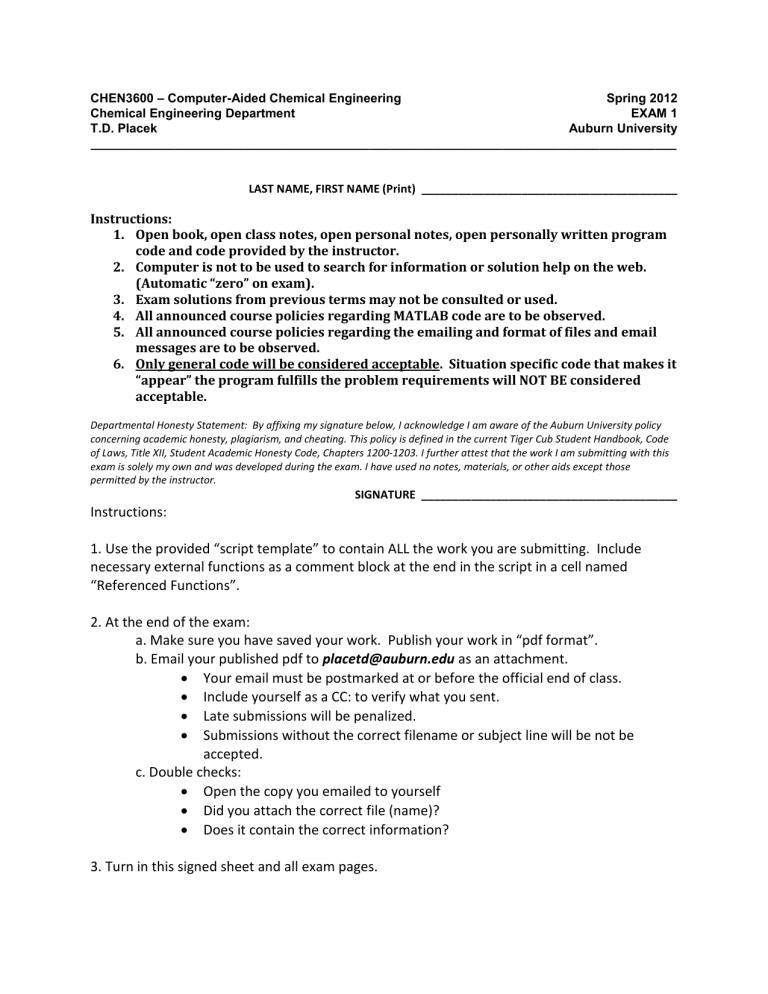
CHEN3600 – Computer-Aided Chemical Engineering
Chemical Engineering Department
Spring 2012
EXAM 1
T.D. Placek Auburn University
____________________________________________________________________________________
LAST NAME, FIRST NAME (Print) _________________________________________
Instructions:
1.
Open book, open class notes, open personal notes, open personally written program code and code provided by the instructor.
2.
Computer is not to be used to search for information or solution help on the web.
(Automatic “zero” on exam).
3.
Exam solutions from previous terms may not be consulted or used.
4.
All announced course policies regarding MATLAB code are to be observed.
5.
All announced course policies regarding the emailing and format of files and email messages are to be observed.
6.
Only general code will be considered acceptable. Situation specific code that makes it
“appear” the program fulfills the problem requirements will NOT BE considered acceptable.
Departmental Honesty Statement: By affixing my signature below, I acknowledge I am aware of the Auburn University policy concerning academic honesty, plagiarism, and cheating. This policy is defined in the current Tiger Cub Student Handbook, Code of Laws, Title XII, Student Academic Honesty Code, Chapters 1200-1203. I further attest that the work I am submitting with this exam is solely my own and was developed during the exam. I have used no notes, materials, or other aids except those permitted by the instructor.
SIGNATURE _________________________________________
Instructions:
1. Use the provided “script template” to contain ALL the work you are submitting. Include necessary external functions as a comment block at the end in the script in a cell named
“Referenced Functions”.
2. At the end of the exam: a. Make sure you have saved your work. Publish your work in “pdf format”. b. Email your published pdf to placetd@auburn.edu as an attachment.
Your email must be postmarked at or before the official end of class.
Include yourself as a CC: to verify what you sent.
Late submissions will be penalized.
Submissions without the correct filename or subject line will be not be accepted. c. Double checks:
Open the copy you emailed to yourself
Did you attach the correct file (name)?
Does it contain the correct information?
3. Turn in this signed sheet and all exam pages.
1: (15%) Explain Question (CLOSED BOOK)
One of the major course outcomes for CHEN 3600 is proficiency in written technical communication. We have also addressed at several points the representation of the learning process via Bloom’s Taxonomy. Provide an explanation of why this skill (written technical communications) is vital in the practice of engineering and how one can employ the concepts expressed in Bloom’s Taxonomy to gain the necessary skills to become proficient in this activity.
Provide an answer that is both concise and clear. Your answer should be provided in the exam template as a commented block of text. For example:
*{ blaa blaa
*}
2: (20-25%) Producing a Graph (Partial Credit Provided)
Produce the following graph EXACTLY 1 as shown below subject to the following limitations, parameters and hints. 1 (For example, the circles are “perfectly round.”) The purpose of this problem is to demonstrate your ability to analyze the behavior of the function as well as to develop a graph meeting specifications. Five (5) extra points will be awarded if your solution does not
involve the use of “if” or “switch” statements.
(Failure to adhere to the problem specifics will result in significant deductions)
1.
The general nature of the graph is three “touching” circles having radius of 2 placed on the x-axis.
2.
The circles are constructed of points not lines. The symbol size is 1.
3.
The equation for a circle of unit radius centered at the origin is related to r cos( ) and r sin(
). The graph is parametric.
4.
Your solution is limited to a single plot statement with a single set of x,y parameters
(i.e., plot(x,y)) which cannot appear in a loop, etc.
3: (15%) Finding the Roots of an Equation (No Partial Credit)
Using the fsolve function, determine all positive roots of the function below. You must employ an anonymous function to solve this problem. sin(3𝑥)
10
+
1 𝑥 3
+ 2𝑒 −𝑥
−1
= 1.5
Be sure to paste your answers in your MATLAB code as a comment!
4: (30%) Programming (Strings) (Partial Credit Allowed)
(a) Write a function called proc1(s) that alternates uppercase and lowercase letters in a string “s”. In this case, the 1 st , 3 rd , 5 th , etc. will be uppercase and the 2 nd , etc. will be lowercase. (see example below)
(b) Write a function called proc2(s) that alternates uppercase and lowercase letters in a string “s”. In this case, the 1 st , 3 rd , 5 th , etc. alphabetic characters will be uppercase and the 2 nd , etc. alphabetic characters will be lowercase. (see example below)
(c) Write a function called proc3(s) that removes all non-alphabetical characters from a string (except blanks which are retained). (see example below)
Hint: There is an upper function and a lower function.
The following is the output from correctly functioning code. You SHOULD test your functions; however, your code may be tested on other strings to assure proper functioning. s1= 'abcdefg 12345 MNOPQRS vwxyz' ; proc1(s1) = AbCdEfG 12345 MnOpQrS VwXyZ proc2(s1) = AbCdEfG 12345 mNoPqRs VwXyZ proc3(s1) = abcdefg MNOPQRS vwxyz
Be sure to paste your answers in your MATLAB code as a comment!
5: (15%) Solving a System of Equations Using fsolve (No Partial Credit)
(a) Using the fsolve function, determine the solution to the following set of equations.
(b) Also determine the residual of the functions at the roots determined.
Hint: Suggested starting values are x = -1, y = 2, z = 5.
Be sure to paste your answers in your MATLAB code as a comment!
2𝑥 − 𝑦 + 𝑧 = 𝑒 −𝑥
−𝑥 + 2𝑦 − 𝑧 = 𝑒 −𝑦 𝑥 + 𝑥𝑦 − 𝑥𝑦𝑧 = 3
